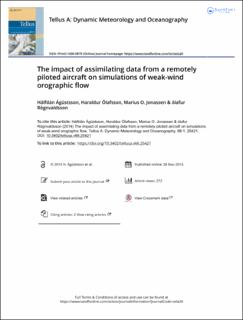| dc.contributor.author | Ágústsson, Hálfdán | |
| dc.contributor.author | Ólafsson, Haraldur | |
| dc.contributor.author | Jonassen, Marius Opsanger | |
| dc.contributor.author | Rögnvaldsson, Ólafur | |
| dc.date.accessioned | 2021-06-28T11:10:28Z | |
| dc.date.available | 2021-06-28T11:10:28Z | |
| dc.date.created | 2021-01-15T16:05:32Z | |
| dc.date.issued | 2014 | |
| dc.identifier.issn | 0280-6495 | |
| dc.identifier.uri | https://hdl.handle.net/11250/2761615 | |
| dc.description.abstract | Orographic winds near a 914 m high mountain in Southwest-Iceland are explored using unique observations made aloft with a small remotely piloted aircraft, as well as with traditional observations and high-resolution atmospheric simulations. There was an inversion well above mountain top level at about 2 km with weak winds below. Observed winds in the lee of the mountain were indicative of flow locally enhanced by wave activity aloft. Winds descended along the lee slope with a prevailing direction away from the mountain. They were relatively strong and gusty at the surface close to the mountain, with a maximum at low levels, and weakening and becoming more diffuse a short distance further downstream. The winds weakened further aloft, with a minimum on average near mountain top level. This situation is reproduced in a high-resolution atmospheric simulation forced with atmospheric analysis as well as with the observed lee-side profiles of wind and temperature below 1.4 km. Without the additional observations consisting of the lee-side profiles, the model fails to reproduce the winds aloft as well as at the surface in a region in the lee of the mountain, as was also the case for the operational numerical models at that time. A sensitivity simulation indicates that this poor performance is a result of the poorly captured strength and sharpness of the inversion aloft. The study illustrates, firstly, that even at very low wind speed, in a close to neutral low-level flow, gravity waves may still be a dominating feature of the flow. Secondly, the study presents an example of the usefulness of lee-side atmospheric profiles, retrieved by simple model aircraft, for improving numerical simulations and short-term weather forecasting in the vicinity of mountains. Thirdly, the study confirms the sensitivity of downslope flow to only moderate change in the sharpness of an upstream inversion. | en_US |
| dc.language.iso | eng | en_US |
| dc.publisher | Taylor and Francis | en_US |
| dc.rights | Navngivelse 4.0 Internasjonal | * |
| dc.rights.uri | http://creativecommons.org/licenses/by/4.0/deed.no | * |
| dc.title | The impact of assimilating data from a remotely piloted aircraft on simulations of weak-wind orographic flow | en_US |
| dc.type | Journal article | en_US |
| dc.type | Peer reviewed | en_US |
| dc.description.version | publishedVersion | en_US |
| dc.rights.holder | Copyright 2014 H. Ágústsson et al. | en_US |
| dc.source.articlenumber | 25421 | en_US |
| cristin.ispublished | true | |
| cristin.fulltext | original | |
| cristin.qualitycode | 2 | |
| dc.identifier.doi | 10.3402/tellusa.v66.25421 | |
| dc.identifier.cristin | 1872324 | |
| dc.source.journal | Tellus A: Dynamic Meteorology and Oceanography | en_US |
| dc.identifier.citation | Tellus A: Dynamic Meteorology and Oceanography. 2014, 66 (1), 1-15. | en_US |
| dc.source.volume | 66 | en_US |
| dc.source.issue | 1 | en_US |

